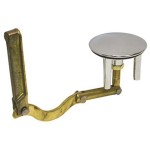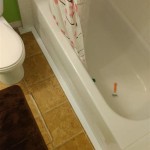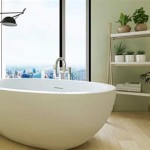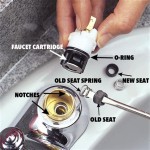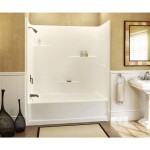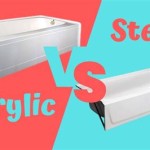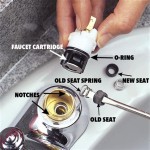How To Clean Bathtub Overflow Plate With Vinegar
The bathtub overflow plate, often overlooked during routine cleaning, can accumulate grime, soap scum, hair, and even mold or mildew over time. This accumulation not only diminishes the aesthetic appeal of the bathroom but can also contribute to unpleasant odors and potentially hinder the overflow drain's function during heavy use of the bathtub. Neglecting this seemingly small area can lead to more significant plumbing problems later on. Using vinegar, a readily available and environmentally friendly cleaning agent, offers an effective method for addressing this common household issue. This article provides a comprehensive guide on how to clean a bathtub overflow plate thoroughly using vinegar.
Before embarking on the cleaning process, it is essential to gather the necessary materials and prepare the area. Improper preparation can lead to frustration and potentially damage the surrounding bathtub surface. A mindful approach ensures a more efficient and effective cleaning outcome.
The following materials are typically required for cleaning a bathtub overflow plate with vinegar:
- White vinegar: The primary cleaning agent, known for its acidic properties that dissolve grime and kill bacteria.
- Small bowl or container: To hold the vinegar solution.
- Old toothbrush or small scrub brush: For scrubbing the overflow plate and surrounding areas.
- Cotton swabs or pipe cleaners: For reaching into tight crevices and around small details.
- Microfiber cloth: For wiping down the cleaned surface.
- Screwdriver (if necessary): To remove the overflow plate for deeper cleaning. Ensure the screwdriver type matches the screw head on your overflow plate to prevent damage.
- Gloves (optional): To protect skin from prolonged exposure to vinegar.
Once the materials are assembled, the area around the overflow plate should be prepared. This involves removing any obstructions, such as bath mats or toiletries, that may hinder access. It's also advisable to protect the surrounding bathtub surface, especially if it's made of delicate material, by laying down a towel or cloth. This precaution prevents accidental scratches or damage from the cleaning process.
Preparation is Key: Setting the Stage for Success
Effective cleaning starts with proper preparation. Consider the condition of the overflow plate and the severity of the buildup. For plates with light grime, soaking may suffice. For more stubborn buildup, more aggressive scrubbing or even removal of the plate may be necessary. Before starting the cleaning process, gather all the necessary supplies within easy reach. This includes the vinegar, toothbrush, cotton swabs, microfiber cloth, and screwdriver (if removal is anticipated). Ensuring all tools are readily available minimizes interruptions and streamlines the cleaning process.
Also, assess the type of overflow plate you have. Some plates are easily removable with a simple screwdriver, while others may be more complex or even permanently attached. Understanding the attachment mechanism helps prevent forcing or damaging the plate during attempted removal.
Ventilation is also an important consideration. Vinegar has a strong odor, so opening a window or turning on the bathroom exhaust fan is recommended. This helps to dissipate the fumes and create a more comfortable working environment. If ventilation is limited, wearing a mask can also help to mitigate the effects of the vinegar odor.
Finally, take a before picture of the overflow plate. This provides a visual reference of the starting condition and serves as a motivational tool to highlight the progress made during the cleaning process. It also helps in identifying areas that may require extra attention during the cleaning process.
With preparation complete, it’s time to proceed with the actual cleaning of the bathtub overflow plate.
The cleaning process involves several steps, from initial soaking to thorough scrubbing and final wiping. The approach should be adapted to the specific condition of the overflow plate and the degree of grime accumulation.
First, pour a small amount of white vinegar into the bowl or container. The amount of vinegar needed depends on the size of the overflow plate and the extent of the grime. A half-cup is typically sufficient for most situations. If the overflow plate is heavily soiled, consider using undiluted vinegar for maximum cleaning power.
Next, soak an old toothbrush or small scrub brush in the vinegar. Ensure the bristles are thoroughly saturated with the vinegar solution to maximize its effectiveness. Gently scrub the overflow plate and the surrounding area around the drain opening. Pay particular attention to crevices and edges where grime tends to accumulate.
For areas that are difficult to reach with a toothbrush, such as inside the drain opening or around small details on the overflow plate, use cotton swabs or pipe cleaners dipped in vinegar. These tools allow for precise cleaning in tight spaces. Stubborn grime may require repeated applications of vinegar and gentle scrubbing.
If the overflow plate is removable, carefully unscrew it using the appropriate screwdriver. Place the removed plate into the bowl of vinegar and allow it to soak for at least 15-30 minutes. This soaking period allows the vinegar to penetrate and loosen the accumulated grime, facilitating easier cleaning.
While the overflow plate is soaking, use the toothbrush and cotton swabs to clean the exposed area inside the drain opening. Flushing the drain with warm water after scrubbing helps to remove loosened debris and vinegar residue.
After soaking, remove the overflow plate from the vinegar and thoroughly scrub both sides with the toothbrush. Rinse the plate under warm water to remove any remaining vinegar and loosened grime. Inspect the plate closely to ensure all traces of dirt and residue have been removed. If necessary, repeat the soaking and scrubbing process.
Once the overflow plate and the surrounding area are clean, wipe them down with a microfiber cloth. This removes any remaining moisture and polishes the surfaces. If the overflow plate was removed, carefully reattach it using the screwdriver, ensuring it is securely fastened. Avoid over-tightening the screws to prevent damage to the plate or the bathtub.
Effective Cleaning Techniques: Maximizing Vinegar's Potential
To maximize the effectiveness of vinegar as a cleaning agent, consider these techniques. Warming the vinegar slightly before use can enhance its cleaning power. However, avoid boiling the vinegar, as this can release harmful fumes. Microwaving the vinegar for a short period is sufficient to warm it. Always exercise caution when handling warm liquids.
For particularly stubborn grime, create a paste of baking soda and vinegar. Apply the paste to the affected area and let it sit for several minutes before scrubbing. The abrasive nature of baking soda combined with the acidity of vinegar creates a powerful cleaning action.
Consider using a specialized cleaning tool, such as a detail brush or a grout brush, for reaching into tight crevices and corners. These tools are designed to effectively remove grime from hard-to-reach areas. If you have hard water issues, you may notice mineral buildup on the overflow plate. In this case, a longer soaking time in vinegar may be necessary to dissolve the mineral deposits. Alternatively, you can use a commercial limescale remover specifically designed for removing hard water stains.
When scrubbing, use gentle but firm pressure. Avoid excessive force, which can damage the overflow plate or the surrounding bathtub surface. Work in a circular motion to effectively loosen and remove grime. Periodically rinse the toothbrush or scrub brush with water to remove accumulated debris and prevent it from being redeposited onto the surface.
After the initial cleaning, consider applying a protective coating to the overflow plate to help prevent future grime buildup. A simple car wax or a sealant designed for bathroom fixtures can create a barrier that repels water and prevents grime from adhering to the surface.
Finally, establish a regular cleaning routine to prevent grime from accumulating to the point where it becomes difficult to remove. A quick wipe-down of the overflow plate with vinegar after each use of the bathtub can significantly reduce the need for more intensive cleaning sessions.
Maintaining Cleanliness: Preventing Future Buildup
Preventive measures are crucial in maintaining the cleanliness of the bathtub overflow plate and minimizing the need for frequent deep cleaning. One simple yet effective strategy is to regularly wipe down the overflow plate with a damp cloth after each use of the bathtub. This removes any residual soap scum or water droplets that can contribute to grime buildup.
Another preventive measure is to install a hair catcher in the bathtub drain. This prevents hair from clogging the drain and accumulating around the overflow plate. Regularly emptying the hair catcher is essential to maintaining its effectiveness.
Consider using liquid soap instead of bar soap. Bar soap tends to leave a residue that can contribute to grime buildup. Liquid soap is less likely to leave a residue and is therefore a preferable option.
Ensure adequate ventilation in the bathroom. Moisture promotes mold and mildew growth, so opening a window or turning on the exhaust fan after each use of the bathtub helps to reduce humidity levels and prevent the growth of these unwanted microorganisms.
Periodically flush the overflow drain with hot water. This helps to remove any accumulated debris and prevent clogging. Pouring a cup of baking soda followed by a cup of vinegar down the overflow drain can also help to clear any blockages and freshen the drain.
Inspect the overflow plate regularly for signs of grime buildup or damage. Early detection allows for prompt action and prevents minor issues from escalating into more significant problems. If you notice any cracks or damage to the overflow plate, replace it immediately to prevent water leaks and further damage.
By implementing these preventive measures, the bathtub overflow plate can be kept clean and grime-free, reducing the need for frequent deep cleaning and prolonging the lifespan of the fixture. A proactive approach to maintenance contributes to a cleaner and more hygienic bathroom environment.

5 Easy Ways To Unclog Bathtub Drain

How To Clear A Clogged Sink Drain With Vinegar Baking Soda

How To Unclog A Bathtub Drain Without Chemicals

4 Ways To Clean A Bathtub Drain Wikihow

How Do You Clean A Trip Lever Drain 3 Steps Done 1 Tom Plumber

4 Ways To Clean A Bathtub Drain Wikihow

How To Clean A Bathtub Drain

How To Clear A Clogged Bathtub Drain

How To Clean Tough Stains From A Bathtub 4 Easy Methods

How Do You Clean A Trip Lever Drain 3 Steps Done 1 Tom Plumber

